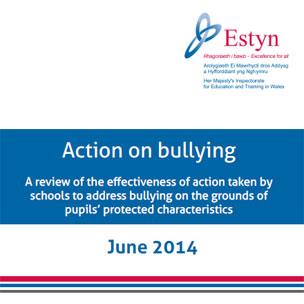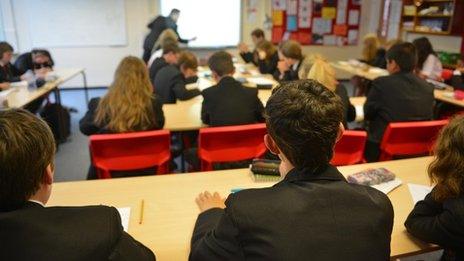Estyn: Too many suffer school bullying in Wales
- Published
School inspectors say 'at risk' groups are targeted
Too many school pupils are still suffering from bullying, Wales' education watchdog is warning.
Estyn says there needs to be greater support for 'at risk' groups who are targeted because of their sexuality, ethnicity, religion or disability.
The rise in cyber bullying is a particular problem for schools because it is anonymous and pupils can be too embarrassed to report it.
Education inspectors have also drawn up an anti-bullying checklist for schools.
The report, external found how different schools deal with bullying varies widely - and even between different staff at the same school.
The rise in cyber bullying was a concern for most secondary schools, with Estyn finding it difficult for staff and pupils and staff to deal with.
It was often unreported because pupils feel too ashamed to talk about it.
Often by the time teachers become aware of cyber bullying, it has been taking place for some time.


The research looked at 21 schools in detail
The report includes a checklist of anti-bullying practices which it recommends schools should have in place.
These include:
All pupils should know what to do if they experience bullying
An agreed definition of bullying understood by everyone in the school
Strategies to tackle cyber bullying
Counselling should be available
Effective supervision between lessons, at breaks and lunchtime
Safe places for vulnerable groups at breaks and lunchtime
Display details of where help is available in school or on help lines
Opportunities for pupils to take responsibility e.g. buddy systems or peer support

Estyn chief inspector Ann Keane said: "Schools should be places where all pupils feel safe and able to learn. Bullying not only affects a child emotionally and psychologically, but can result in poor attendance and underachievement."
While exact figures are not known, studies estimate between one-fifth and a half of all pupils suffered bullying at some point.

Cyberbullying through social network sites has been identified as a growing problem

Tackling cyber bullying case study - Dwr-y-Felin School, Neath
A detailed anti-bullying policy is in place
E-safety is taught in IT, social education and assemblies
Staff do not allow mobile phone use and monitor internet use with a sophisticated system linked to the school network
The school works closely with police liaison officers to support pupils whether cyber bullying has taken place in or out of school.
Source: Estyn

Pupils in secondary schools are less confident than younger children that the school would be able to do anything about it.
But some schools are praised for good initiatives aimed at preventing bullying.
They included Hafod Primary School, Swansea, for its panel of pupils able to call suspected bullies to account and Eveswell Primary School in Newport for eradicating homophobic language.
Crickhowell High School, Powys, was praised for creating a more tolerant atmosphere by teaching pupils about diversity and equality through the curriculum.
- Published4 April 2014

- Published3 April 2014

- Published18 November 2013

- Published15 October 2013

- Published19 August 2013
